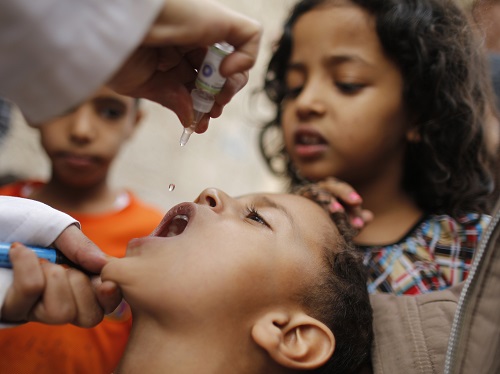
Taking up both of the two polio vaccines can best protect against the disease, new research shows.
Researchers found that administering IPV after OPV improved immunity and body's ability to protect against the disease.
Polio or poliomyelitis is an infectious disease that affects small children aged below five. Two Austrian physicians - Karl Landsteiner and Erwin Popper- were the first to identify the main culprit behind the disease, the polio virus, back in 1908.
The virus, according to World Health Organisation (WHO), enters body through contaminated water or food, invades the nervous system and causes total paralysis within a short time. Some common symptoms of the disease include fever, fatigue, headache, vomiting, stiffness in the neck and limb pain.
Two types of vaccines are available to protect against the disease - the Inactivated Polio Vaccine (IPV) and Oral Polio Vaccine (OPV).
Developed by an American virologist, Jonas Edward Salk, in 1955, IPV that is administered via injection uses inactivated or killed polio virus strains to fight all three strains of poliovirus.
OPV was developed by Polish American researcher Albert Bruce Sabin. This vaccine uses weakened virus strain to trigger immune response in the body, thus helping in the formation of antibodies. The weakened virus injected into the body as vaccine is subsequently destroyed by the antibodies created by the body.
OPV soon became the "vaccine of choice" in most of the countries around the world, due to its easy oral administration, ability to strengthen the intestinal immunity, lasting effect and low cost, WHO said.
Still, choosing the right vaccine had been difficult in countries severely affected by the disease mainly because of the negative impact of OPV vaccine on mucosal immunity that helps protect the skin layer mucous membranes against bacterial pathogens.
As this issue can only be solved through administration of multiple doses, eradication of polio virus from conflict zones and remote areas always remained quite challenging. Additionally, in an unhygienic environment, the weakened polio virus in stools survives and eventually transforms to a form that can paralyse people.
According to an estimate from the WHO, more than 2.5 billion children across the world have received oral polio vaccine in the past decade. During the period, though the vaccination helped in preventing 8.5 million polio cases, 20 countries reported 655 vaccine derived polio virus (VDPV) cases.
To resolve this problem, researchers administered either IPV or OPV to 1,000 infants and children in Uttar Pradesh. One month after administering OPV, researchers tested blood and stool collected from the children. Administration of IPV in children already vaccinated with OPV was associated with fewer viral shedding and improved intestinal mucosal immunity.
"This study revolutionised our understanding of IPV and how to use it in the global eradication effort to ensure children receive the best and quickest protection possible from this disease," senior author Dr Bruce Aylward, assistant director-general for Polio, Emergencies and Country Collaboration at the WHO, said in a news release.
Though polio cases have declined significantly over the years, concerns surged last year due to polio outbreak in countries including Afghanistan, Pakistan, Syria, Nigeria, Kenya, Somalia, Ethiopia and Cameroon. To prevent re-entry of polio virus from these countries, Indian Ministry of Health and Family Welfare, have made OPV compulsory for all travellers visiting or going out of the country.
The study has also been reported in journal Science.

















